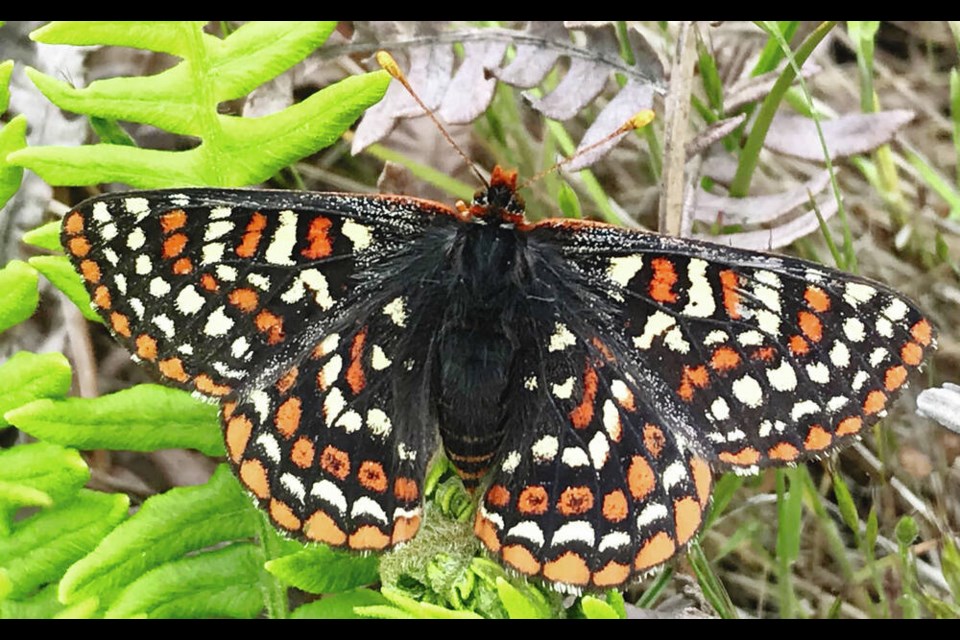A rare butterfly thought to be extinct in Canada is making a comeback on Vancouver Island, and getting some human help on Hornby and Denman islands.
The Taylor’s checkerspot, with its exquisite black, orange and white patterns, was once living in Greater Victoria and north to Hornby, with pockets of the insects in coastal regions of Oregon and Washington.
But the populations of Taylor’s checkerspots on the Island were believed to be extirpated from Canada in 1990 when intensive searches of its key habitat areas revealed no signs of them.
However, small groups of Taylor checkerspots were discovered on Denman Island in 2005 and in a rural area south of Campbell River in 2018, which has spurred a massive re-introduction effort on Hornby.
Over three weeks in March, B.C. Parks staff and a legion of other conservation groups and volunteers released more than 5,400 larvae in a designated area of Helliwell Provincial Park. The fuzzy black caterpillars are tiny, about as long as your thumbnail.
The species is considered critically endangered by the federal government and is on the province’s Red List of at-risk species.
According to Wildlife Preservation Canada, which helped rear the larvae with the Greater Vancouver Zoo, the checkerspot’s sensitivity to changes in its habitat makes it an indicator species — an environmental indicator for the health of the entire ecosystem.
The Taylor’s checkerspot is the darkest subspecies of the Edith’s checkerspot and has a wingspan of less than six centimetres. Adults emerge in April and May, when they mate and lay clusters of as many as 1,200 eggs. The larvae that emerge pause their development in mid-June to early July and hibernate through the winter.
The recovery project team includes representatives from Ministry of Environment, B.C. Parks, K’ómoks First Nation, Greater Vancouver Zoo, B.C. Conservation Foundation, Mosaic Forest Management, Conservancy Hornby Island, the Hornby Island Natural History Centre and Hornby Island Provincial Parks Committee.
“We know from other projects that releasing at least 5,000 larvae per year for at least five years seems to be what is needed to establish a population because that will usually result in about 250 adult butterflies each year,” said Jennifer Heron, chair of the Taylor’s Checkerspot Butterfly Recovery Project Team and provincial invertebrate conservation specialist with the Ministry of Land, Water and Resource Stewardship.
Chris Junck of the Garry Oak Ecosystems Recovery Team and the checkerspot project said B.C. Parks has created a 10-hectare parcel of North Denman Provincial Park and Protected Area as a special butterfly reserve.
He said the recovery initiative required extensive habitat restoration such as selective tree and invasive plant removal, as well as adding native plants, grasses and seeds.
He said although the former clearcut focused on Taylor’s checkerspot butterflies, several other at-risk and uncommon coastal bluff species benefit from the project, such as dun skipper butterflies and about a dozen other range-restricted butterflies, western bumble bee, bats, western screech-owl and numerous other birds and plants.
Junck said the larvae are also feeding on some non-native plant species such as English plantain.
“Many of the caterpillars immediately began searching for their favourite foods, such as the leaves of small-flowered blue-eyed Mary or harsh paintbrush,” said Junck. “If all goes well, they will progress through a few more developmental stages, pupate, and then emerge as spectacular orange, black and white checkered butterflies in late April to early June.”
Although the Greater Vancouver Zoo is now producing the larvae, the first captive breeding program was conducted on Denman Island in 2013 by Peter Karsten, a former director of the Calgary Zoo who retired to Denman. He continued for four years until the zoo took over.
Butterflies have been emerging for several years with some success after a release of 800 larvae in 2020 and 1,300 last year. It’s hoped that major releases like this month’s over the next four years will bring higher populations that can be sustained.
The key to building the butterfly population is protecting habitat, said Junck. Trampling is a major threat for caterpillars and their food plants and park visitors can help protect the caterpillars by staying on the trails that are delineated by ropes and restoration area signs. Visitors are reminded that dogs must be on a leash and bikes aren’t allowed in the butterfly reserve or the park.
There is also concern about predators such as wasps and birds, and large storms.
> Report sightings to [email protected], or use the free iNaturalist app. The app is a species identification tool that enables citizen scientists to record and contribute species data for projects around the globe.




